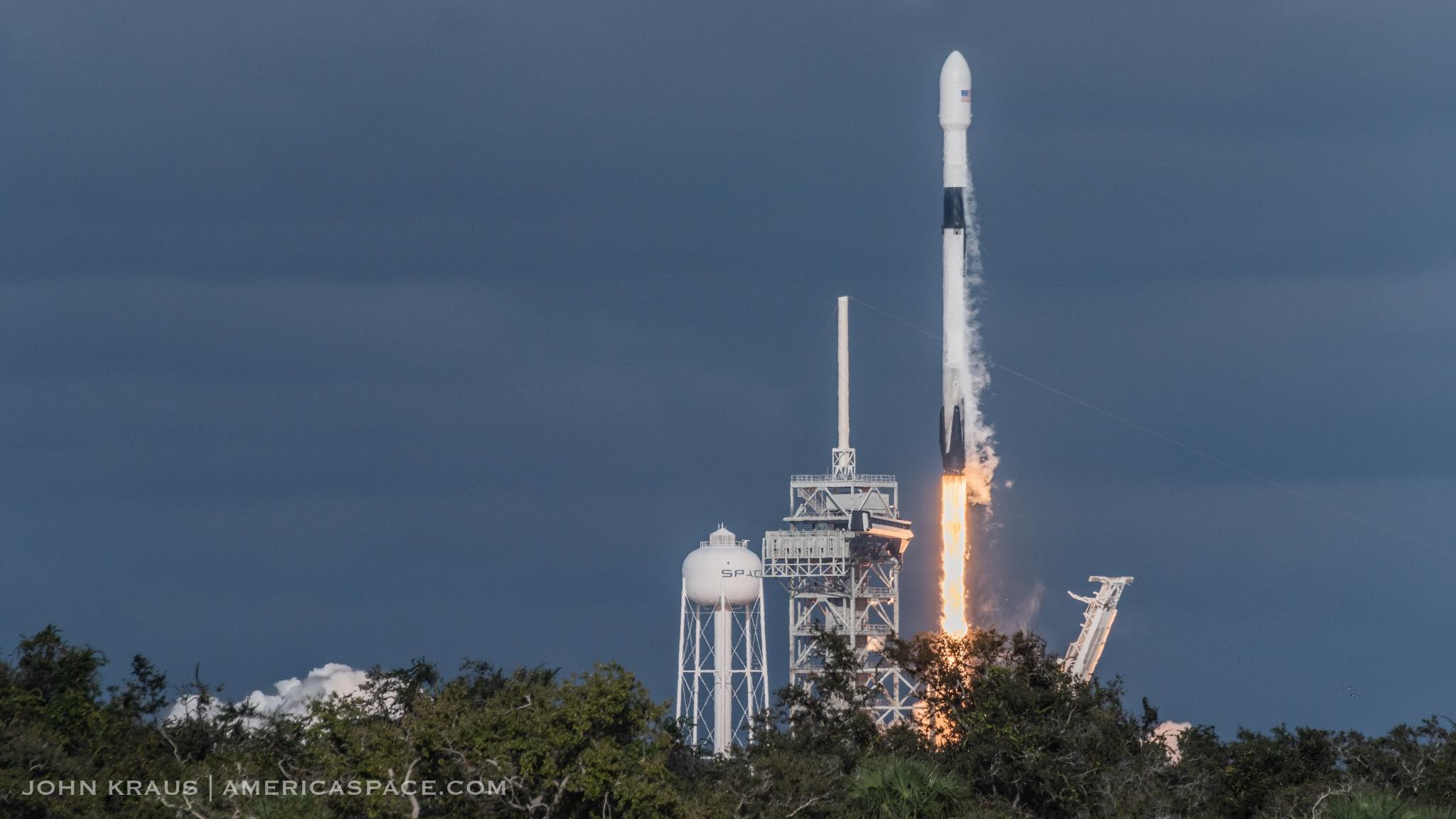
Less than four months since it successfully lofted the Telstar 19V communications satellite to orbit, a Block 5 Upgraded Falcon 9 first stage roared skyward from historic Pad 39A at NASA’s Kennedy Space Center (KSC) in Florida. Aboard the booster—designated “B1047”, which is the third Block 5 to be reused in less than six months—was Qatar’s Es’hail-2 communications satellite, which includes the first amateur radio payload to voyage to geostationary orbit.
Liftoff occurred at 3:46 p.m. EST Thursday, right on the opening of a 103-minute “window”, and its success enabled SpaceX to tie its own “personal best” of 18 launches in a single calendar year. With today’s launch success, attention turns to Vandenberg Air Force Base, Calif., where another Block 5 is being readied to fly on a never-before-attempted third mission on 19 November.
Built by Tokyo-based Mitsubishi Electric Corp., Es’hail-2 finally reaches space around two years later than originally intended. Contracts to build the satellite were signed between Mitsubishi Electric and Doha-headquartered Es’hailSat Qatar Satellite Company in September 2014, marking the first occasion that a Japanese spacecraft manufacturer had entered the Arab commercial communications satellite market.
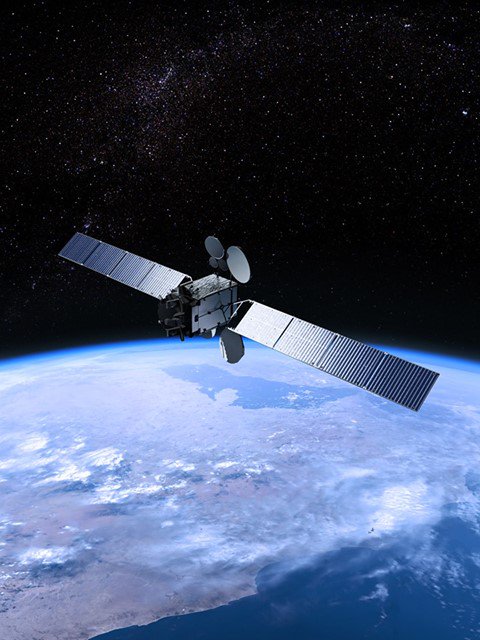
The original expectation was that it would launch in late 2016. Es’hail-2 is based on Mitsubishi Electric’s tried-and-true DS-2000 bus, which weighs approximately 6,600 pounds (3,000 kg) and can support hybrid communications payloads and provide a power output approaching 15 kilowatts. The cube-shaped satellite—which completed its critical design review phase in September 2015 and underwent vacuum-chamber testing in Japan in mid-2016—is furnished with Ku-band and Ka-band transponders and is expected to remain operational for up to 15 years. It marks Qatar’s second communications satellite, following the launch of Es’hail-1 aboard an Ariane 5 rocket from Kourou, French Guiana, back in September 2013.
When fully operational, Es’hail-2 will sit at 25.5 degrees East longitude, providing communications services for the Qatari government and high-quality, premium direct-to-home television content throughout the Middle East and North Africa (MENA) Region. Space News previously reported that the satellite may be equipped with an anti-jamming capability, “which Middle Eastern operators find increasingly necessary in the wake of politically motivated jamming of satellite television signals in the region”.
Additionally, the satellite carries a pair of AMSAT Phase 4A transponders, representing the first amateur radio payload to geostationary altitude, which reportedly could link operators from Thailand to Brazil. In addition to fabrication of the satellite itself, Mitsubishi Electric has also provided ground systems and training services to afford Es’hailSat a full “turnkey” product. Following the contracts to build Es’hail-2, SpaceX was signed up to launch the mission, with an original target of late 2016. That date slipped repeatedly, due in part to delays in SpaceX’s launch manifest.
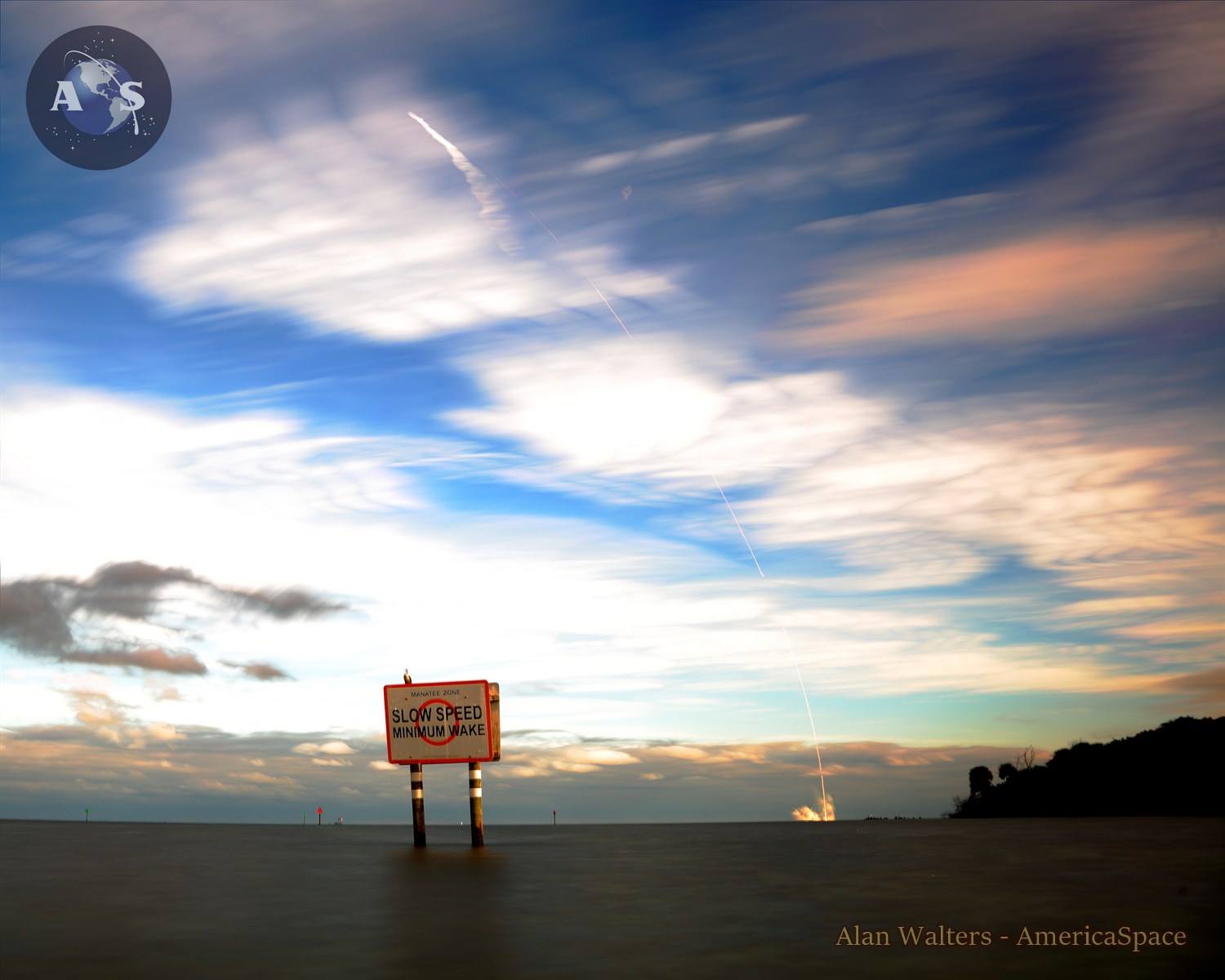
In readiness for Thursday’s flight, the Upgraded Falcon 9 was transported out to Pad 39A on Monday for a customary Static Fire Test of its nine Merlin 1D+ first-stage engines, which occurred under cover of darkness that evening. As is normal, the booster was lowered and returned to the horizontal integration facility, where the bullet-like payload fairing—which housed Es’hail-2—was installed. The 230-foot-tall (70-meter) rocket was then returned to Pad 39A, to await SpaceX’s first launch from the historic complex since the Bangabandhu-1 mission in May 2018.
Weather conditions for Thursday’s opening launch attempt were expected to be 60-percent favorable, according to the 45th Weather Squadron at Patrick Air Force Base. “Southerly winds will create isolated showers and warm temperatures across Central Florida as the high-pressure ridge retreats east,” it was reported Tuesday. “By Thursday, the strong high-pressure push behind the front will bring cooler, drier air into Florida, moving through the Spaceport Thursday morning. Cloudiness and rain will diminish during the day as the boundary passes south of the area. The primary weather concerns are lingering thick cloud layers and cumulus clouds associated with the front.” It was noted that a 24-hour scrub to Friday would yield a markedly improved picture, with a 90-percent probability of acceptable weather.
Loading of the Block 5 booster with liquid oxygen and a highly refined form of rocket-grade kerosene (known as “RP-1”) got underway an hour prior to Thursday afternoon’s launch attempt. Passing T-10 minutes, the terminal countdown autosequencer was initiated and the Merlin 1D+ engines were chilled, ahead of ignition. At T-2 minutes, the Air Force Range Safety Officer declared all ground assets as “Go for Launch” and the Upgraded Falcon 9 transitioned to Internal Power and assumed primary command of all critical functions, going into “Startup” at T-1 minute. At this stage, the Niagara deluge system began flooding the pad surface with 30,000 gallons (113,500 liters) of water, per minute, to suppress the acoustic energy. The Eastern Range declared its readiness to support the launch as “Green”. Three seconds before liftoff, the Merlins roared to life, pumping out a combined thrust of 1.5 million pounds (680,000 kg) of thrust. Liftoff occurred on-time at 3:46 p.m. EST.
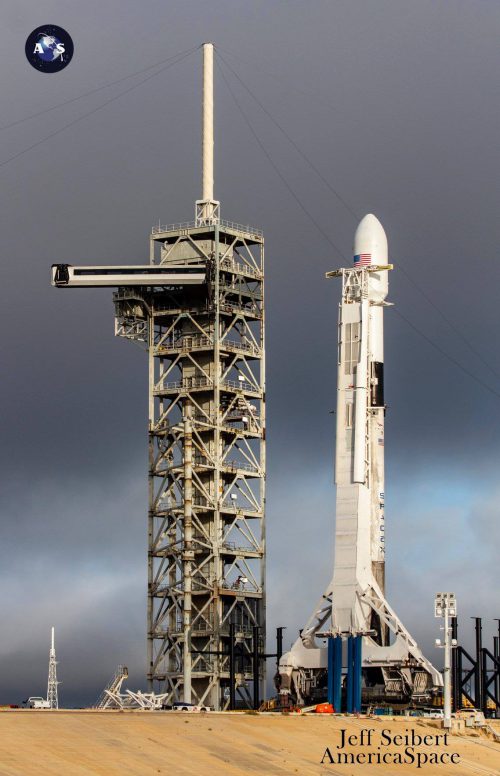
Immediately after clearing the tower, the Upgraded Falcon 9 executed a combined pitch, roll and yaw program maneuver to establish itself onto the proper flight azimuth to inject the heavyweight Telstar 19V into its high orbit. Passing the point of maximum aerodynamic turbulence (colloquially dubbed “Max Q”) at 70 seconds into the flight, the booster later throttled back two of the Merlins to reduce the rate of acceleration at Main Engine Cutoff (MECO). Two and a half minutes after launch, the seven remaining Merlins fell silent and the first stage separated from the stack. It was now the turn of the second stage, equipped with a single, restartable Merlin 1D+ Vacuum engine, capable of 210,000 pounds (92,250 kg). This now picked up the baton for a pair of lengthy “burns” to deliver its payload into orbit.
Although the primary focus of today’s launch was to launch Es’hail-2, the discarded first stage was assigned the secondary objective of returning to a soft landing on the Autonomous Spaceport Drone Ship (ASDS)—dubbed “Of Course I Still Love You”—at a location some 420 miles (680 km) off the Cape, in the Atlantic Ocean. Today’s smooth touchdown on OCISLY marks the seventh landing of 2018, as SpaceX sought to use up its older stock of flown Block 4 Falcon 9 cores and transition to the Block 5. All told, it was the 19th successful landing of a Falcon 9 first stage on the deck of a drone ship since April 2016.
In equaling its 2017 personal best of 18 missions, SpaceX has scored a raft of astonishing accomplishments in 2018, recently capped by last month’s first successful Return to Launch Site (RTLS) of an Upgraded Falcon 9 first stage at Vandenberg. Additionally, the Hawthorne, Calif.-based launch services organization has now delivered eight communications satellite to geostationary altitude, two Dragon cargo missions to the International Space Station (ISS) and, in early February, lofted the maiden voyage of the mammoth Falcon Heavy.
FOLLOW AmericaSpace on Facebook and Twitter!
.




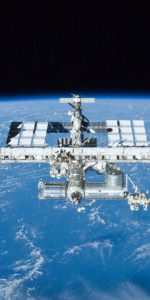
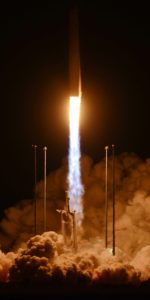
In the left screen of the booster as it was about to fire its initial reentry burn, did anyone else see an object on the screen in the upper right? The booster went past the object quickly (2-3 sec) come and gone. Initially, it looked like a speck except it grew in size in the 1:30-3 quadrant. Anyone else notice this? Thoughts on what it might be? Too high for an aircraft.
On the replay at Space-X, the object can be seen at 21:03 on the tape. Would welcome ideas…..
At first I thought it was from the engine section of the booster but, looking at it closely, it seems to be a free-flying object. What is up there at 60+ miles in altitude that would pass that close without the origin of the object being the booster itself?
If you accept that it originated with the booster but at an earlier separation/release event, then how is it that the two separated and then came back together before the re-entry burn?
And, carrying this a bit further, what would have happened if the object struck the returning booster? If it has any mass, the relative speed was enough to do some damage, possibly catastrophic.
Methinks SpaceX needs to figure out if this originated with the booster, and, if not, then, ‘Holy Shit! What was that?’ … now SpaceX REALLY needs to figure this out!
Nicely put, Kudos!